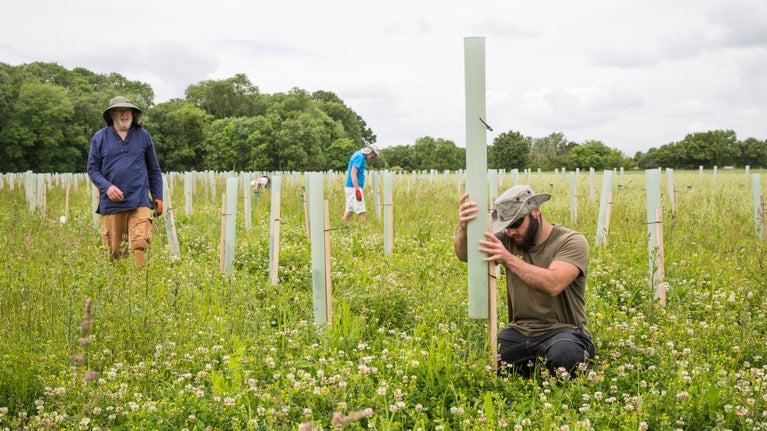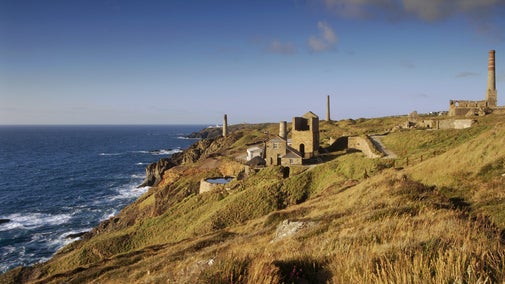
Tackling climate change
Uncover how we’re responding to the changing climate at places in our care.

The Anthropocene is the idea that the Earth is entering a new epoch in its geological history in which human beings have, for the first time, become the primary agents of change on a planetary scale. This gives the new epoch its name. ‘Anthro’ is derived from the Greek for ‘human’ and stands alongside other geological epochs, such as the Holocene which began at the end of the last Ice Age, around 12,000 years ago.
Although various origins have been suggested for the Anthropocene, the emergence of the Industrial Revolution in Britain during the 18th and early 19th centuries is one of the most widely accepted by historians. The term was first used in the 1970s but didn’t enter common usage with its current meaning until the early 2000s.
The Industrial Revolution saw the appearance of the world’s first fossil fuel economy through its exploitation of Britain’s coal reserves. What followed was a huge intensification in the mechanisation of work and transport, thanks to the development of a more efficient steam engine by James Watt and Matthew Boulton from 1769.
Northeastern coal barons like George Bowes of Gibside developed their mines to fuel the booming metropolis of London after 1700. Cotton mills like Quarry Bank started using water power, but by the early 19th century were increasingly converting to carbon-hungry steam.
The period saw the beginning of widespread pollution of land, air and water as factories pumped out smoke, effluents and other waste products. Meanwhile, urban areas began to grow fast, adding to the environmental problems.
As the numbers of humans expanded rapidly, many species of animals, fish, birds, and plants began to decline. New evidence suggests that by the mid-19th century the burning of coal to power the industries that were spreading across Europe and the United States had already begun to nudge global temperatures upwards.
Humans have likely used more energy since 1900 than in all of the preceding human history combined. By the end of the 20th century a scientific consensus emerged that, primarily due to the burning of fossil fuels, global warming of the atmosphere was taking place at an accelerating rate.
This has affected the polar regions most immediately, but today there’s a growing understanding of the links to rising sea levels, extreme weather events and desertification. Meanwhile, the use and continued testing of nuclear weapons from 1945 provided a new global marker (sometimes referred to as a 'golden spike') for the Anthropocene. The worldwide presence of radioactive fallout, which will remain detectable in the earth's soils for at least 100,000 years, is favoured by some geologists as marking the definitive transition out of the Holocene.
The concept of the Anthropocene has been strongly criticised by some scholars for appearing to suggest that humanity as a whole is responsible for the environmental damage caused. In fact, it’s a highly unequal process, with western societies accounting for the vast majority of energy use, industrial production and pollution in the past, present and foreseeable future. Nevertheless, the Anthropocene has begun to inspire a new generation to understand more clearly who and what is responsible for the ecological changes going on around us.
Although the industrial past has led to dire environmental consequences, it’s still an important part of our heritage. You can learn more about the era at many National Trust places and, in some cases, see nature begin to flourish again.

Used for military activity for much of the 20th century, Orford Ness was part of the Atomic Weapons Research Establishment until 1971. Testing for the UK's nuclear weapons programme was undertaken here from the early 1950s. Today the site is littered with debris and unusual buildings from its military past but it has been reclaimed by nature and is now a designated nature reserve.
WE177A thermonuclear bomb, Orford Ness
The testing of thermonuclear fusion weapons during the Cold War released radioactive isotopes high into the atmosphere that then settled into the soils and sediments of the planet as fallout. Plutonium-239, used both in weapons and power stations, has a half-life of over 24,000 years and has been identified as a global marker for the onset of the Anthropocene. The existence of weapons such as WE177A demonstrates how one species on Earth, Homo sapiens, now has the capacity to extinguish not only itself but most – possibly all – life on the planet.
Samuel Greg’s cotton mill at Quarry Bank was built in 1784. Originally reliant on water power, the Gregs installed their first coal-powered Boulton and Watt engine in 1810, before making a more complete transition to steam mechanisation in the mid-1830s. You can find out what life was like for both the cotton mill owners as well as the pauper children who worked 10-hour days and lived in cramped conditions. You can also stroll along the riverside paths and in the adjacent woodland, imagining how different it would have been in the industrial era.
Opened in 1820 to mine tin and copper, the Levant Mine is part of the industrial coastal landscape that runs south to Botallack and Cape Cornwall. The steam-powered beam engine, built in the 1840s and used to drain water from the mine, has been restored to operation.
Historical paintings and artefacts can help us learn how things were before large-scale industrial effects were felt across the globe.
John James Audubon was an ornithologist, artist and naturalist who was celebrated for his drawings and paintings of North American birds. In early-19th century America, passenger pigeons flew in vast flocks a mile wide – with total numbers likely to have been around 3 billion – before rapidly going extinct (the last passenger pigeon, Martha, died in Cincinnati zoo on 1 September 1914).
Biologists still debate why the passenger pigeon went extinct so quickly, but the impact of humans – especially hunting and the destruction of woodland habitat for farmland – was likely the major factor.
This painting is part of the Ightham Mote collection
As a result of global warming, many of the world’s glaciers have begun to shrink with alarming rapidity. The Mer de Glace near Chamonix in France has both retreated and thinned over recent decades, with the loss of ice accelerating after the year 2000. It is estimated that it may have retreated by at least another 1,200 metres by 2040. Old maps, drawings and photographs like this one in the Fox Talbot Museum are a valuable source in estimating how glaciers have changed over time.
This article contains contributions from Scott Ashley at the University of Newcastle.

Uncover how we’re responding to the changing climate at places in our care.
Find out more about our Trusted Source articles, which were created in partnership with the University of Oxford, and explore topics related to the special places in our care.

Find out how we're planting and establish 20 million trees that will absorb carbon and help tackle climate change.
Discover more about the National Trust’s role at COP26 in Glasgow and how you can help tackle the climate crisis.

Internationally important coastal nature reserve, with a fascinating 20th-century military history

The working mill is the beating heart of Quarry Bank. Set in picturesque gardens and countryside, explore one of Britain's greatest industrial heritage sites.

High-up on the exposed cliffs of the 'Tin Coast' and part of the Cornish Mining World Heritage Site. At its heart, the restored 1840s beam engine running on steam. Open by pre-booked tours.
